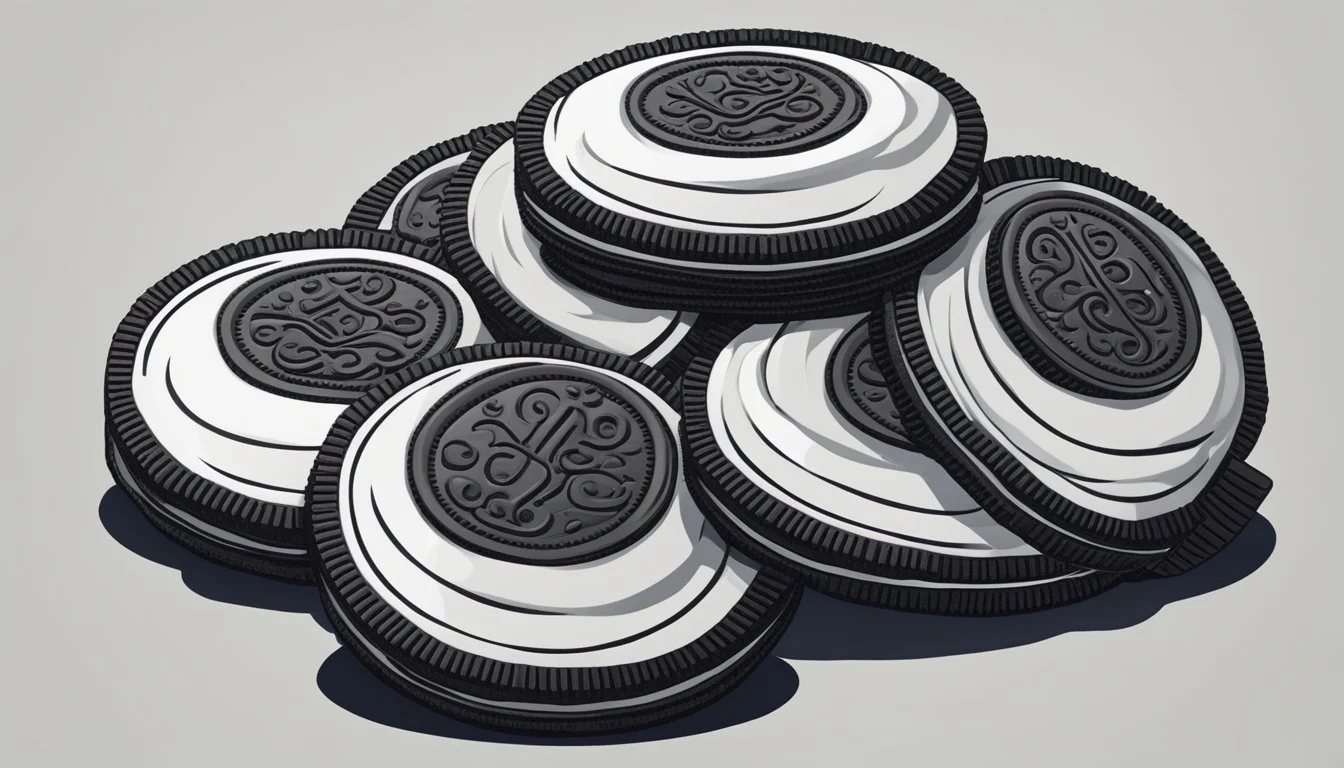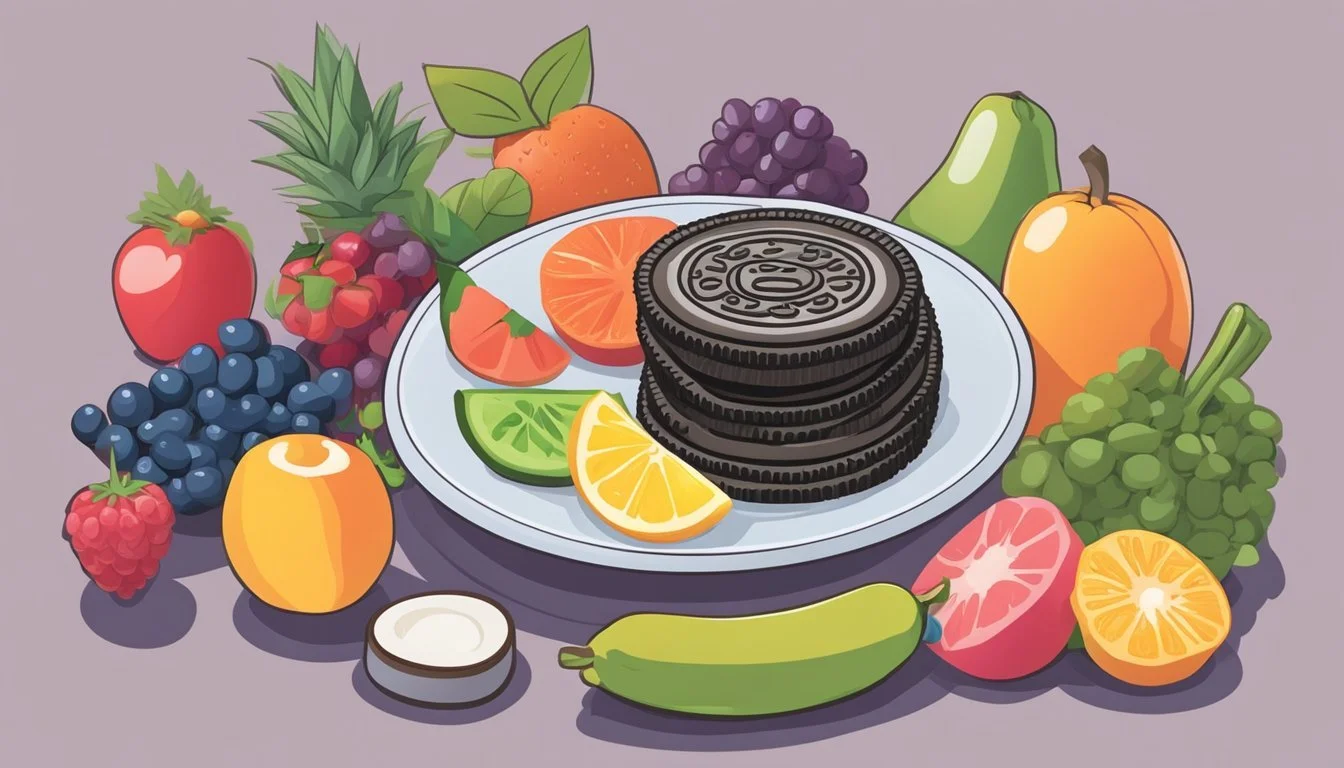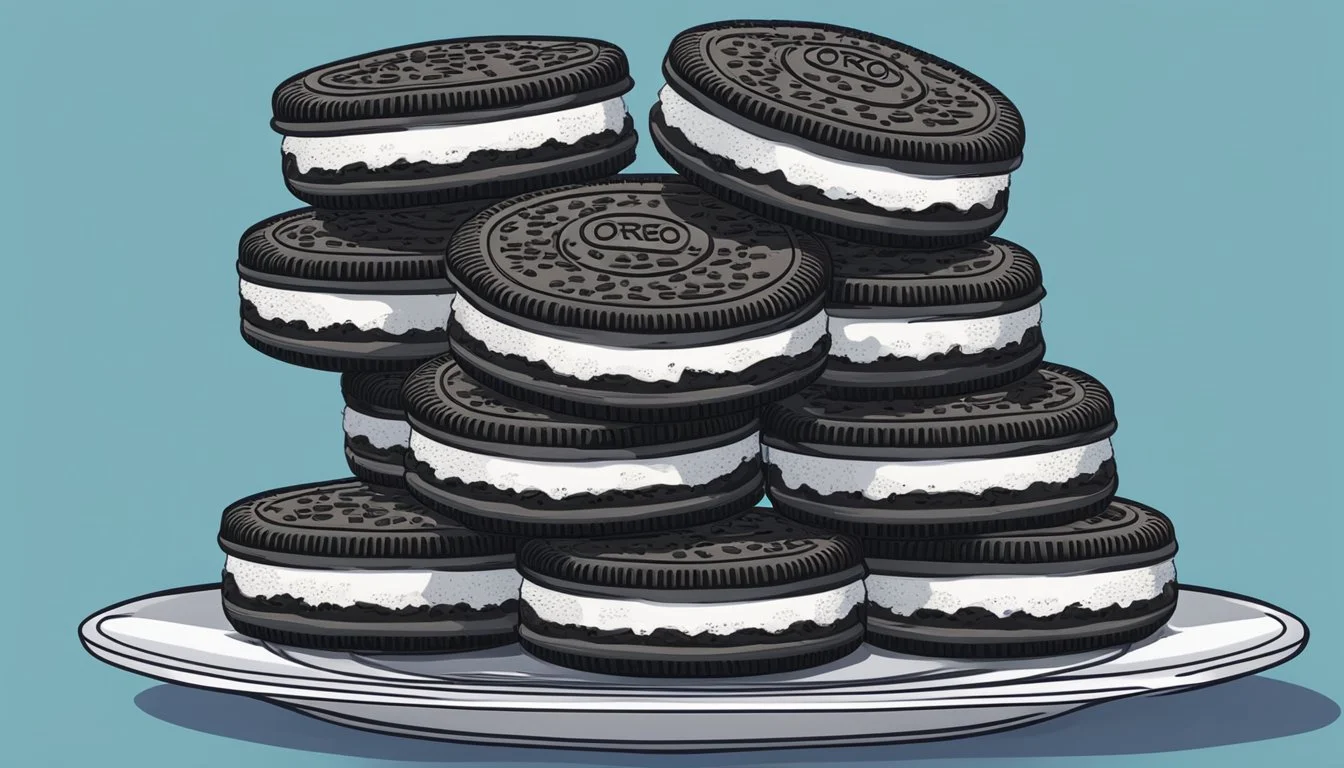How Many Servings of Oreo Cookies Per Day is Too Much?
Understanding Safe Limits
Determining the right amount of any snack, including Oreo cookies, hinges on understanding both nutritional content and individual dietary needs. Oreo cookies, a popular treat known for their sweet cream sandwiched between two chocolate wafers, have a certain allure that can make them hard to resist. A single Oreo cookie contains about 53 calories, while a serving of six cookies amounts to around 270 calories. This number can quickly add up, as Oreos also contain sugar and fats that contribute to their calorie count.
When assessing the consumption of Oreos, it is important to acknowledge that while they can fit into a balanced diet, moderation is key. The main ingredients of Oreos—processed flour, sugar, and oil—are low in essential nutrients, which is why they are often labeled as empty calories. Even though they are not a substantial source of fiber or protein, which are important for satiety and nutritional value, the pleasure of enjoying an occasional Oreo can be part of a varied diet.
Establishing a threshold for how many servings of Oreo cookies per day is too much depends largely on individual calorie and nutrient needs. These needs vary based on age, sex, weight, metabolic rate, and level of physical activity. Therefore, while it is difficult to set a one-size-fits-all limit, considering Oreos as an occasional treat rather than a daily indulgence is a balanced approach. This helps to leave room for more nutrient-dense foods while still enjoying the small pleasures of a beloved cookie.
Understanding Oreo Cookies
When discussing Oreo cookies, it is crucial to be mindful of the various types available and their nutritional content. These factors play an essential role in determining how many servings per day may be too much.
Oreo Varieties
Oreo cookies come in an array of varieties, each distinguished by their unique flavor profile and ingredients. The classic Original Oreo is known for its two chocolate-flavored wafers with a sweet cream filling. Double Stuf Oreos contain double the cream filling, while Oreo Thins offer a lighter, crispier eating experience with less cream. Golden Oreos deviate from the traditional chocolate cookie, featuring vanilla-flavored wafers instead.
While Oreos are not marketed as health foods, it's important to acknowledge the presence of palm oil, refined flour, and added sugars. These ingredients can impact dietary considerations for those monitoring their intake of fats, sugars, and carbohydrates. For individuals with dietary restrictions, there are gluten-free versions available, but standard Oreos contain gluten from the wheat flour. As for dairy content, while Oreos do not contain milk, they are not certified vegan due to potential cross-contact with milk at the manufacturing site.
Nutritional Information
The nutrition facts of Oreo cookies vary based on the specific variety, but here's a brief overview of the standard Original Oreo:
Nutrient Amount Per Serving (2 cookies) Calories 140 Total Fat 7g Saturated Fat 2g Trans Fat 0g Cholesterol 0mg Sodium 135mg Total Carbohydrates 21g Dietary Fiber <1g Total Sugars 13g Includes Added Sugars 12g Protein 1g
One should note that Double Stuf Oreos, due to their larger cream content, will have higher fat and calorie counts compared to their counterparts. On the contrary, Oreo Thins tend to have fewer calories and less fat. Consumers looking for an alternative to the classic chocolate cookie can opt for Golden Oreos, though the nutritional content remains similar in terms of calories, fat, and sugar content.
It is essential for individuals to consider their overall dietary patterns and health goals when determining the appropriate serving size of Oreo cookies. The combination of fat, especially saturated fat, and sugars in Oreos can contribute to an increased caloric intake if consumed in large quantities, potentially disrupting a balanced diet.
Health Considerations for Oreo Consumption
Consuming Oreo cookies within moderation does not typically pose significant health risks, but it's essential to understand the daily intake limits and the potential consequences of overconsumption.
Daily Intake Limit
A single serving of Oreos is typically considered to be three cookies, which contains about 14 grams of sugar and 160 calories. The American Heart Association advises limiting daily added sugar intake to no more than 36 grams for men and 25 grams for women to maintain good health. Consistently exceeding these sugar recommendations can lead to health complications.
Risks of Overconsumption
Weight Gain and Obesity: High calorie content with low nutritional value can lead to energy imbalances and weight gain over time.
Diabetes and Insulin Resistance: Regularly consuming high amounts of sugar from Oreos can increase the risk of developing type 2 diabetes due to the potential for insulin resistance.
Heart Disease: Excessive Oreo consumption contributes to a higher intake of sodium and added sugars, which may increase the risk for heart diseases.
Addiction and Binge Eating Disorder: Sweet and high-fat foods like Oreos can trigger binge eating tendencies, potentially leading to a form of addiction that requires professional attention.
Oreo Cookies in a Balanced Diet
Oreo cookies can be part of a balanced diet when consumed in moderation due to their high sugar and fat content. Understanding serving size and exploring healthy alternatives are essential for incorporating Oreos without disrupting nutritional goals.
Moderation and Serving Size
It is recommended that an individual limits their intake of Oreos to the serving size specified on the package, which is typically three cookies. Each Oreo cookie contains approximately 52 calories and 2.3 grams of fat, including both saturated and unsaturated fats. A standard serving thus provides about 156 calories and 6.9 grams of fat.
Sugar: A serving of three cookies also comes with around 14 grams of sugar, which is a substantial portion of the American Heart Association's daily added sugar limit of 25 grams for women and 36 grams for men.
Protein and Fiber: Oreos provide less than 1 gram of fiber per serving and only minimal protein, both of which are essential for a balanced diet.
To maintain energy and support weight loss goals, cookies should be eaten in moderation and not as a primary source of nutrition.
Healthy Alternatives
Searching for substitutes that satisfy the craving for something sweet while also offering nutritional benefits is a viable strategy. One can consider the following alternatives:
Dark Chocolate: A square or two can provide the same satisfaction with less sugar and additional antioxidants.
Almonds: A handful of almonds offers protein, healthy fats, and fiber, while also helping to manage hunger.
Shifting the focus to snacks that contribute to overall health rather than empty calories is crucial. Aim for treats that complement a nutritious diet and support a healthy lifestyle when the craving for Oreo cookies arises.
Comparative Analysis of Cookie Consumption
When considering cookie consumption, especially among popular choices such as Oreos, it's crucial to evaluate the nutritional content and frequency of intake in comparison to similar products.
Comparing Oreo Cookies with Alternatives
Oreos: Known for their distinctive black-and-white appearance, Oreos consist of two chocolate-flavored wafers with a sweet creme filling. They contain sugar, unbleached enriched flour, palm and/or canola oil, cocoa, and high fructose corn syrup, making them a highly processed food.
Servings: Typically, a serving size for Oreos is three cookies.
Caloric Content: Approximately 160 calories per serving.
Chips Ahoy: Chips Ahoy is another household name, offering a crunchy texture and packed with chocolate chips. Ingredients include unbleached enriched flour, semisweet chocolate chips, sugar, and canola oil.
Servings: A standard serving of Chips Ahoy is roughly three cookies.
Caloric Content: Around 160 calories per serving.
Nutter Butter: For fans of peanut flavor, Nutter Butter cookies present a peanut-shaped sandwich cookie filled with peanut butter cream. They are composed of enriched flour, sugar, peanut butter, and vegetable oil among other ingredients.
Servings: Typically, a serving size is two cookies.
Caloric Content: About 120-130 calories per serving.
Nilla Wafers: Nilla Wafers provide a simpler flavor profile with a light, vanilla taste. Main ingredients include unbleached enriched flour, sugar, soybean oil, and less than 2% of high fructose corn syrup.
Servings: Generally consumed in servings of eight wafers.
Caloric Content: Around 140 calories per serving.
It is integral to consider the types of oil used in these cookies. Both vegetable oil and canola oil, common in processed foods, are relatively high in calories and fat. However, canola oil contains lower levels of saturated fats compared to other vegetable oils.
Cookie Type Serving Size Calories per Serving Common Oils Oreos 3 cookies 160 Palm and/or canola oil Chips Ahoy 3 cookies 160 Canola oil Nutter Butter 2 cookies 120-130 Vegetable oil Nilla Wafers 8 wafers 140 Soybean oil
This comparison highlights the similarities and differences in serving sizes and calorie counts among popular cookie brands, providing clarity to consumers on their choices.
Consumer Guidance
When indulging in Oreo cookies, it is crucial for consumers to consider both moderation and nutritional content. This section provides insight into making more informed choices and understanding packaging labels.
Identifying Healthier Choices
Consumers may attempt to choose healthier options within the range of Oreo products. Classic Oreo cookies contain processed flour, sugars, and oils. For those seeking an alternative, Oreo offers a variety of products, some of which may be labeled as "Thins" or may use alternate ingredients to cater to different dietary needs, such as vegan or gluten-free options. Typically, these variants contain fewer calories and lower sugar content per serving compared to regular Oreos.
Oreo Variant Key Nutritional Fact Original Approx. 160 calories per 3-cookie serving. Thins Approx. 140 calories per 4-cookie serving. Gluten-Free Similar to original in calorie content. Vegan No animal-derived ingredients.
Note: Specific nutrition may vary. Always check packaging for the most current information.
Interpreting Labels and Claims
Understanding food labels is essential for maintaining a balanced intake. Oreo cookies, like many packaged foods, come with nutrition labels that specify the number of servings per container and the nutritional content per serving. The serving size is typically listed as a number of cookies—usually around three cookies per serving. Labels may also make various claims such as "low fat" or "reduced calorie."
Serving Size: Consumers should check the number of cookies classified as a single serving to gauge their intake.
Daily Intake Limit: A moderate approach is advised, aligning with dietary guidelines for occasional treats rather than everyday consumption.
Nutrition: Key nutritional metrics such as calories, sugars, and fats are listed on labels and should be compared to the recommended daily values.
The label claims must comply with regulatory standards, ensuring that consumers are not misled by advertising. Consumers are encouraged to review the privacy policy and company statements for information regarding nutrition and health claims.
Oreo Cookie Controversies and Myths
When discussing the health impacts of consuming Oreo cookies, there is often misinformation that can lead to misconceptions. This section aims to clarify some of the controversies and myths surrounding Oreos, particularly addressing the erroneous comparison to drugs and misconceptions about their potential for addiction.
Addressing Myths about Oreos
Calorie Content: It's important to recognize that Oreo cookies are high in calories, which can contribute to overeating and, potentially, obesity if consumed in large quantities. The American Heart Association (AHA) recommends limiting added sugars, which include those found in Oreos.
Sugar Content: A concern often associated with Oreos is their sugar content. An excessive intake of sugary treats like Oreos could lead to health issues such as obesity and related diseases.
The Oreo-Cocaine Comparison
Comparison Claims: Claims have circulated comparing the addictive potential of Oreos with cocaine.
Addiction Perspective: While Oreos can be very palatable, leading some to feel they can't stop eating them, likening their potential for addiction to that of cocaine, a powerful and illegal substance, is an exaggeration. It is vital to approach such comparisons with skepticism.
Scientific Evidence: There is currently no scientific evidence to substantiate the claim that Oreos, or any other food, could elicit the same addictive response in the brain as cocaine does. The comparison may come from anecdotal experiences of craving, but should not be taken literally.








